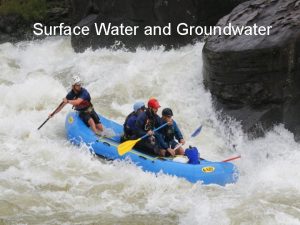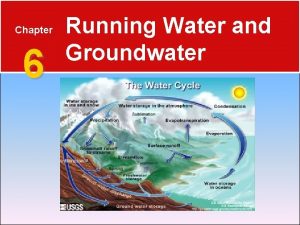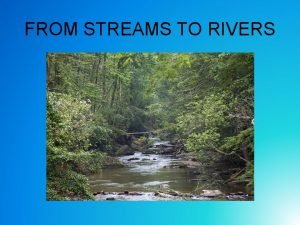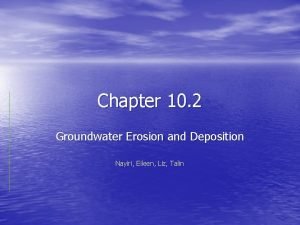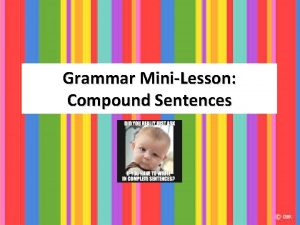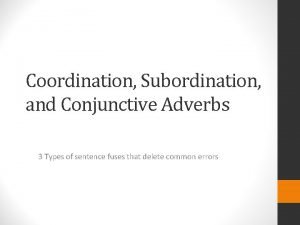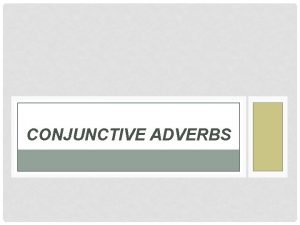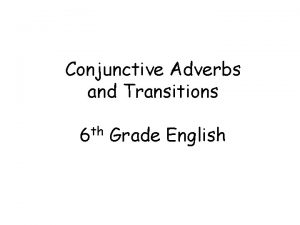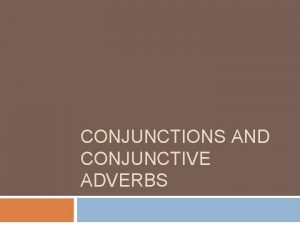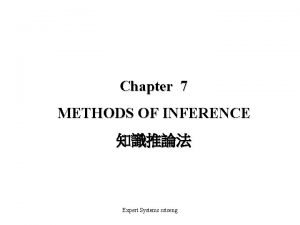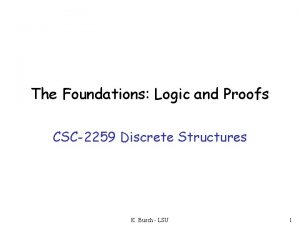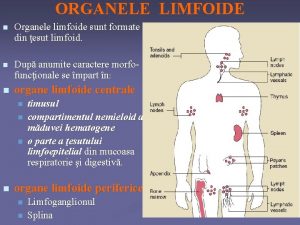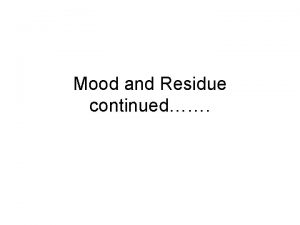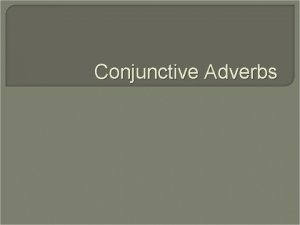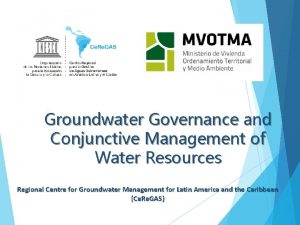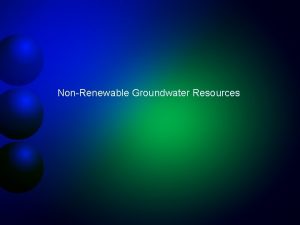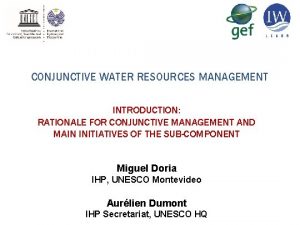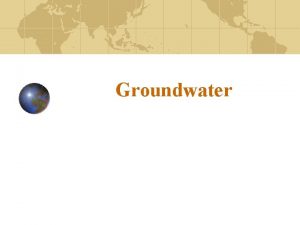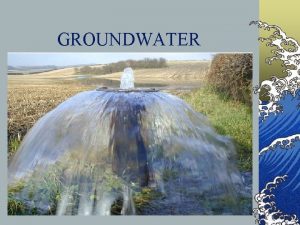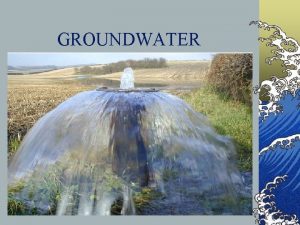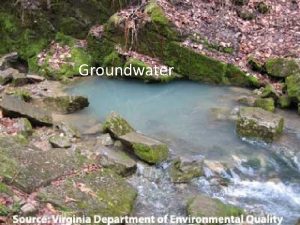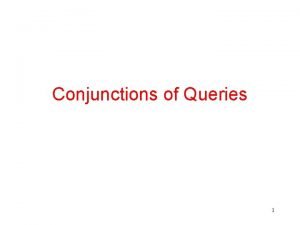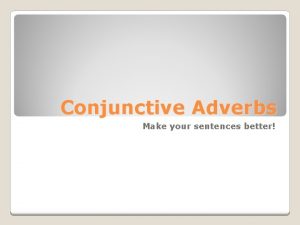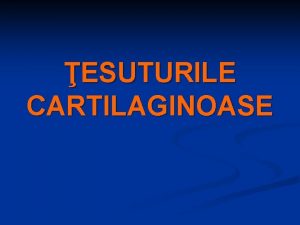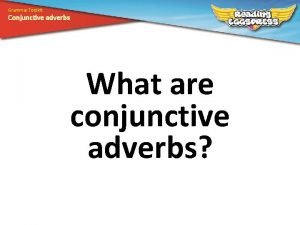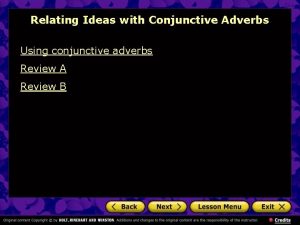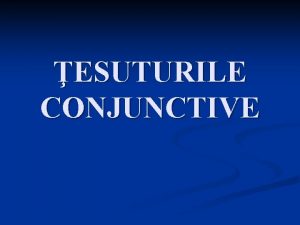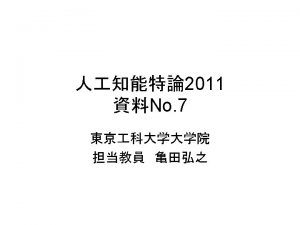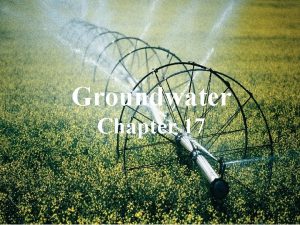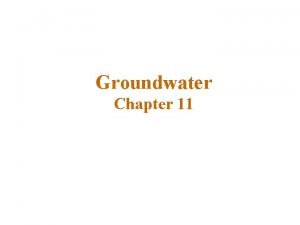Groundwater Governance and Conjunctive Management of Water Resources





















- Slides: 21

Groundwater Governance and Conjunctive Management of Water Resources Regional Centre for Groundwater Management for Latin America and the Caribbean (Ce. Re. GAS)

Regional Centre for Groundwater Management for Latin America and the Caribbean (Ce. Re. GAS) Ce. Re. GAS is a UNESCO Category II Center with a regional scope in Latin America and the Caribbean, based in Uruguay and created with the mission of articulating national and regional capacities at the public and/or private level for the sustainable management of aquifers and protection of the water resource under a comprehensive approach that contemplates the environmental, economic and social values, in line with the international commitments assumed by the country and the region in the matter of sustainable development.

Conjunctive Use Conjunctive use describes the combined use of groundwater and surface water. In order to achieve higher water reliability, the natural hydrologic connection between groundwater and surface water is used as efficiently as possible. Conjunctive water management is an improved form of conjunctive use.

Conjunctive Management An approach to water resources management in which surface water and groundwater are considered as one single component, and therefore are managed in closest possible coordination, in order to maximize overall benefits from water. Taking fully into account the natural and maninduced interactions between ground-water and surface water, as well as on opportunities to combine the use and control of surface water and groundwater. view purpose looking at

Direct and indirect connection Source: World Bank – GW MATE

Complementarity The different and complementary characteristics and behaviors of surface water and groundwater make possible to meet the specific requirements of quantity and quality of water more adequately and economically than if both resources were used separately. Source: Integration of Groundwater Management into Transboundary Basin Organizations- in Africa – AGWnet, BGR, IWMI, Cap. Net, ANBO,

Actions (Interconnected) Conjunctive management actions at field level, grouped according to their main immediate objectives Surface water = All water above the ground level. Evapotranspiration, dependant ecosystems, etc. included • speaking in terms of win-win for « resource augmentation » in a context of « conjunctive management » means that we are not just adding new resources to satisfy demand but that the selection of the new resource should potentially allow reducing the pressure on other existing resources through some kind of optimization. • when looking at the level control, this includes both situations where a certain level should be maintain to ensure flow to streams and wetlands (ecosystems) or other situation where, at the countrary, drainage should take place to prevent flooding. • regarding pollution this is for instance ensuring that emergency groundwater sources are available in case of pollution of surface water

Key elements of conjunctive surface water and groundwater management at all scales Ø Recognizing the interaction between surface water and groundwater (water budgets, flow overlap, identification of dependant ecosystems, etc. ) Ø Integrated information about surface water and groundwater and effective monitoring systems Ø Effective mechanisms for coordinating surface water and groundwater management at all scales Ø Legislative framework identifying the goal of conjunctive water management Ø Policies identifying measures for conjunctive water management and roles and responsibilities for implementation Ø Water plans that take account of the opportunities for conjunctive water management and impacts of surface water and groundwater use.

Conjunctive management: A CONTRIBUTION TO IWRM • IWRM a broad concept: • Integrated water resources management (IWRM) is a systematic process for the sustainable development, allocation and monitoring of water resource use in the context of social, economic and environmental objectives. • IWRM is based on the understanding that all the different uses of finite water resources are interdependent. • IWRM is hence a “process which promotes the coordinated development and management of water, land related resources in order to maximise the resultant economic and social welfare in an equitable manner, without compromising the sustainability of vital ecosystems. ” (GWP) • « Conjunctive management » looks at particular aspects on IWRM.

Groundwater Resources Governance Understand the difference between Governance and Management to operate the change Good Governance Arrangements DEFINITION Groundwater governance is the process by which groundwater is managed through the application of responsibility, participation, information availability, transparency, custom, and rule of law. Groundwater governance is the process by which administrative actions and decision making are coordinated between and among different jurisdictional levels-one of which may be global. Conjunctive Management

GROUNDWATER GOVERNANCE Project: A GLOBAL FRAMEWORK FOR ACTION GEF IW-FAO-IAH-UNESCO-World Bank Thanks to UNESCO-IHP Network Latin America & Caribbean 19 countries Sub-Saharan Africa 19 countries UNESCO IHP has organized 5 Regional Consultations Regional Diagnostics / Recommendations Asia & Pacific 17 countries Framework for Action Arab States 19 countries UNECE region 22 countries + private sector Providing policy makers with science-based guidelines for informed decision making

Project Main Outcomes Global Diagnostic: Knowledge and experience; threats to and impediments for good governance A Shared Global Vision 2030: Governance level to achieve Framework For Action: • Policy and institutional guidelines, recommendations, best practices • Context-adaptable process

Groundwater Governance Project http: //www. groundwatergovernance. org/ • • Bring to the global attention the urgent need for improved governance of groundwater resources Identify and promote globally valid guiding principles for managing groundwater resources at the national level Framework for Action The FFA proposes activities on 5 themes All 5 themes have implications / applications in terms of Conjunctive management

The Framework For Action: Structure The FFA proposes activities on 5 themes 1) Initial steps to establish an adequate basis for groundwater governance Good governance requires: • political commitment and leadership, • knowledge and awareness and • stakeholder involvement. This theme proposes ways in which these general conditions may be put in place.

The Framework For Action: Structure The FFA proposes activities on 5 themes 2) Strengthening institutions in groundwater governance: Institutions provide the enabling environment for groundwater management. Effective institutions will have the ability to plan for the future. They have legitimacy in the eyes of stakeholders, are inclusive, and are characterized by credible and verifiable commitments. To move to effective groundwater governance is a step-wise process. Different countries have different starting points and varied capacity to progress.

The Framework For Action: Structure The FFA proposes activities on 5 themes 3) Creating linkages with main interrelated areas of human action and policy Establishing linkages to other water resources and to other sectors is a requisite of governance. Connections to the management of other water sources and other sectors need to be systematically made to ensure mainstreaming of groundwater into the policies of those sectors.

The Framework For Action: Structure The FFA proposes activities on 5 themes 4) Redirecting finances (investments and incentives) for effective groundwater management In many countries, incentive policies and public expenditures at present do little to promote sustainable and efficient groundwater management, and often even do harm. There is also, in general, a need to invest much more in groundwater governance. It is important that the basic functions of regulation, planning and monitoring are not under-resourced.

The Framework For Action: Structure The FFA proposes activities on 5 themes 5) Establishing a process of groundwater planning and management The final theme of action is to start the process of planning and management, beginning with priority aquifers where pressures are high and interests large. Special arrangements are required for vulnerable situations – such as non-renewable groundwater systems, fast-growing cities or small island states.

The Framework For Action: Implementation Call for Action Implementation of the Framework can achieve the Vision – but this will require concerted action from stakeholders at all levels It calls for action by actors both inside and outside the water community to safeguard the many beneficial and essential functions of groundwater for future generations. To achieve this Vision, all stakeholders have their part to play Where can you contribute ?

Final thoughts The planned conjunctive use of groundwater and surface water (management) has the potential to offer benefits in terms of economic and social outcomes through a significant increase in water use efficiency. There is a significant difference between unplanned and planned conjunctive use. When surface and groundwater sources are directly available to the end user, spontaneous conjunctive use tends to proliferate. It is therefore of great importance the approach on the governance of water resources in order to maximize the benefits of conjunctive management. While the challenges and benefits associated with the conjunctive management, under a strategical approach, are well understood and are the subject of many written reports, the current state of conjunctive water management around the world suggests that little has been achieved in its implementation.

Thank you Muchas gracias Tel: +598 2903 6008 SKYPE: ceregas 2015 Av. Rondeau 1665 piso 1. Montevideo Uruguay
 Water and water and water water
Water and water and water water Running water and groundwater
Running water and groundwater Chapter 6 running water and groundwater
Chapter 6 running water and groundwater The term geologists use for underground water is
The term geologists use for underground water is How does groundwater rejoin the water cycle
How does groundwater rejoin the water cycle Transformation processes
Transformation processes Variable resources examples
Variable resources examples Groundwater erosion and deposition
Groundwater erosion and deposition Renewable resources vs nonrenewable resources
Renewable resources vs nonrenewable resources Compound sentence examples
Compound sentence examples What is swabi in english
What is swabi in english Conjunctive adverbs vs subordinating conjunctions
Conjunctive adverbs vs subordinating conjunctions Conjunctive adverbs
Conjunctive adverbs Conjunctive adverb
Conjunctive adverb Conjunctive adverbs
Conjunctive adverbs Compound sentence with conjunctive adverb
Compound sentence with conjunctive adverb Rule of conjunctive simplification
Rule of conjunctive simplification Prove modus tollens
Prove modus tollens Macrofage
Macrofage Mood adjunct examples
Mood adjunct examples Conjunctive decision rule
Conjunctive decision rule Clasificati tesuturile animale
Clasificati tesuturile animale

